More than 470 types of birds have been identified in Louisiana, and about 22 of those are sparrows. Some sparrows are long-distance migrants, whereas others are partial migrants or even non-migratory residents of Louisiana.
Louisiana’s diverse landscapes give sparrows many kinds of habitat options, including woodlands, salt marshes, wetlands, agricultural fields, urban areas, and more.
Before we take a look at these 22 different kinds of sparrows, let’s make sure we’re all on the same page about what makes a sparrow a sparrow.
What Are Sparrows?
Sparrows are often called “Little Brown Jobs,” or LBJs, because they have similar markings.
Sparrows are members of the Passeridae family, which also includes towhees, buntings, and larks.
Sparrows are usually beige or brown with a varied amount of darker or lighter streaking. Although they aren’t very colorful birds, they may have some subtle gray, yellow, rufous, and pink on their bodies. The subtlety in their coloring allows them to be excellent at camouflage.
These little birds are usually between 5-7 inches in length and have short, sharp bills. Their wing shape, tail length, leg length, and other aspects of their silhouette vary from one kind of sparrow to another.
Sparrows can be difficult to get close to, as many species are shy and prone to hiding. When you do see them, it can be difficult to remember which markings are on which sparrows. But with practice, you can learn to identify these Little Brown Jobs and tell the difference, one from another.
What Kind of Sparrows Are in Louisiana?
Our list includes 22 different sparrows. We are not covering the very rarely documented, once-in-a-lifetime visitors to Louisiana. Instead, this list identifies the sparrows you are most likely to see here.
Interestingly, there are only two sparrows that live in Louisiana exclusively during the summer – the Chipping Sparrow and the Lark Sparrow. Rather, there are mostly year-round varieties, many more that come here during the winter, and one that visits as it migrates between its breeding and winter territories.
For our list, all of our information about when and where sparrows are in Louisiana comes from one of the most reputable birding resources in the world: The Cornell Lab of Ornithology. Sometimes you may find subtle differences in range maps for different kinds of sparrows, but we trust the Cornell Lab for its excellent reputation.
Learning to ID Sparrows
It’s true that identifying sparrows is challenging – but it’s something that can be done!
Taking note of the following characteristics will help:
- Colors and patterns on the bird’s feathers
- Colors and description of the bird’s bill and legs
- Silhouette (the bird’s shape)
- Habitat where the bird was spotted
- Area of Louisiana
- Time of year
- Bird’s activities when sighted (hiding, perching, singing, scurrying on the ground, eating)
- What it was eating (if anything)
All of this information should help you begin to identify sparrows in Louisiana! Let’s get started on our list of sparrows in the Bayou State.
Year-Round Sparrows in Louisiana
5 kinds of sparrows are found in Louisiana throughout the year. These are also the only kinds of sparrows seen here in the summer, as there are no sparrow varieties that migrate to Louisiana for their breeding season. If you see a sparrow in the summertime in Louisiana, it’s one of these 7! They are: The Bachman’s Sparrow, the Eastern Towhee, the Grasshopper Sparrow, the House Sparrow, and the Seaside Sparrow.
Bachman’s Sparrow

- Peucaea aestivalis
- Order: Passeriformes
- Family: Passerellidae
- Length: 5.9-6.7 inches (15-17 cm)
- Weight: 0.8-1.3 oz (23-37 g)
- Wingspan: 8.7-9.4 inches (22-24 cm)
Bachman’s Sparrow is a small songbird known for its streaked brown plumage on the back and wings, complemented by buffy underparts. It has a grayish-brown crown and a subtle white eye-ring. They are a Red List Watch Species, which makes them rare in Louisiana.
If you’re lucky enough to find them in Louisiana, Bachman’s Sparrow can be found in various habitats throughout the year. During the breeding season, it favors open pine woodlands with a dense understory of grasses and shrubs. This species thrives in areas with abundant tall grasses, such as longleaf pine forests and pine savannas. In winter, they may also occupy mixed pine-hardwood forests and shrubby areas, utilizing the diverse plant cover for foraging and shelter.
They avoid the state’s coastal waters altogether.
Other interesting facts about Bachman’s Sparrow include its unique breeding strategy. Males collect materials like grass stems and pine needles, while females build cup-shaped nests hidden within grass clumps or shrubs. The sparrows have a melodic song that is made up of clear notes followed by a trill. It is a territorial call. They primarily feed on insects, spiders, and seeds, foraging on the ground by scratching the leaf litter with their feet.
Because Bachman’s Sparrows are endangered, efforts are underway to protect their habitats and ensure their long-term survival.
Eastern Towhee

- Pipilo erythrophthalmus
- Order: Passeriformes
- Family: Passerellidae
- Length: 6.8-9.1 inches (17-23 cm)
- Weight: 1.2-1.8 oz (34-51 g)
- Wingspan: 8.7-11.8 inches (22-30 cm)
The Eastern Towhee is a medium-sized sparrow with striking, dark-colored plumage. Males have a black head, upper body, and tail, while their underparts are white. The wings are black with white patches, and the eyes are vibrant red. Females have a similar pattern but with brown replacing black.
In Louisiana, the Eastern Towhee can be found in a variety of habitats, including forests, thickets, and shrubby areas. They prefer areas with dense understory vegetation for foraging and nesting. During the breeding season, their distinctive “Drink-your-tea!” call can be heard throughout the day.
The Eastern Towhee feeds primarily on the ground, scratching the leaf litter to uncover insects, seeds, and berries. They have a unique foraging behavior where they perform backward and forward hops, uncovering hidden prey items.
They are year-round residents of most of Louisiana, but they tend to be winter-only visitors along both the western border of the state and in the Greater New Orleans area.
Grasshopper Sparrow
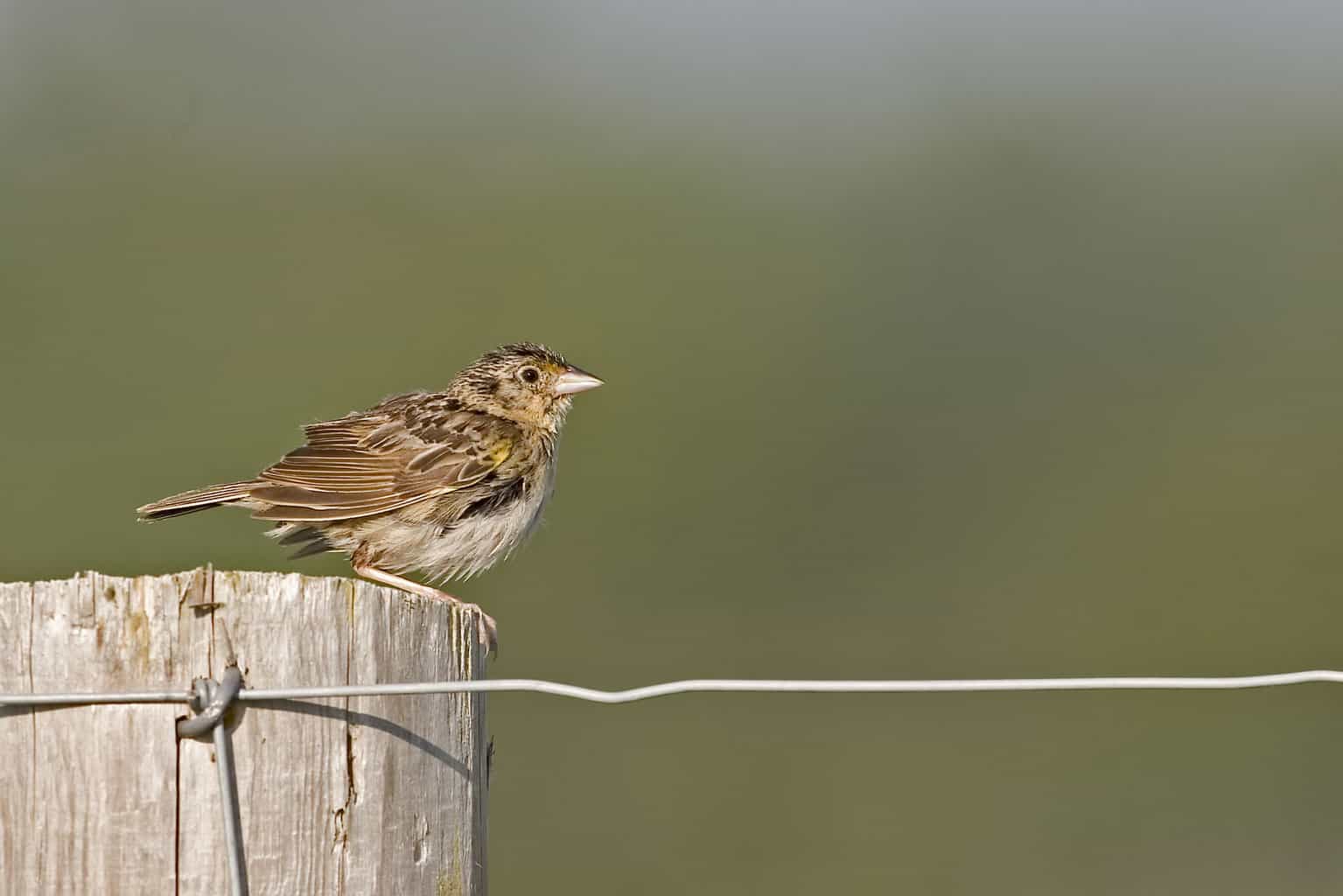
- Ammodramus savannarum
- Order: Passeriformes
- Family: Passerellidae
- Length: 4.7-5.5 inches (12-14 cm)
- Weight: 0.4-0.6 oz (11-17 g)
- Wingspan: 7.5-9.4 inches (19-24 cm)
The Grasshopper Sparrow is a small sparrow with a subtle yet charming appearance. It has a brownish upper body with dark streaks and a pale underbody. Its face features a pale stripe above the eye and a thin dark line running through it.
In Louisiana, the Grasshopper Sparrow can be found in grasslands, prairies, and agricultural fields. They prefer areas with tall grasses and scattered shrubs for nesting and foraging. Their song is a distinctive insect-like buzzing, earning them their name.
They are year-round residents of most of the state, with some populations staying along the coastline year-round.
Grasshopper Sparrows primarily feed on insects, spiders, and seeds. They forage on the ground or within low vegetation, using their sharp beak to capture prey.
House Sparrow
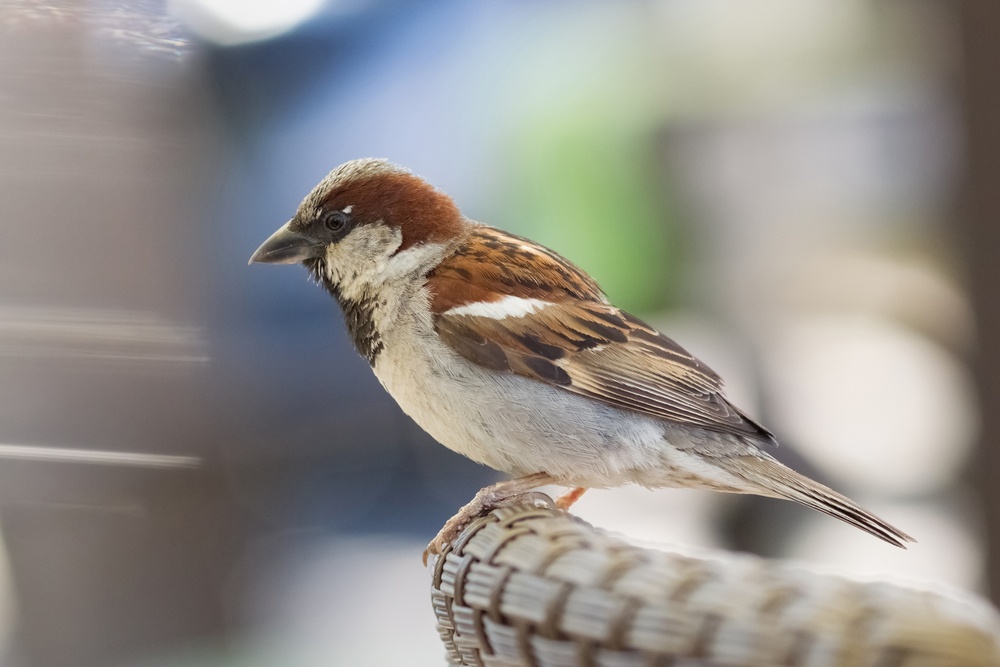
- Passer domesticus
- Order: Passeriformes
- Family: Passeridae
- Length: 5.5-6.7 inches (14-17 cm)
- Weight: 1.1-1.5 oz (30-42 g)
- Wingspan: 7.5-9.8 inches (19-25 cm)
The House Sparrow is a small bird known for its close association with human activity. Unlike sparrows that avoid people, House Sparrows only live near people.
The House Sparrow has a plump body with a short, thick bill and a rounded head. Males have a gray crown, black bib, and chestnut nape, while females are more subtly colored with streaked brown plumage.
House Sparrows are incredibly adaptable and can be found in various habitats, including urban areas, farmlands, and open woodlands. They are known to form large flocks and frequently build their nests in cavities, such as tree holes, crevices, and man-made structures. As invasive species, they cause problems for native species in most areas where they live. They are aggressive and territorial.
These sparrows are opportunistic feeders, consuming a diverse diet that includes seeds, grains, fruits, insects, and even human food scraps. Their persistent chirping and chattering can be heard throughout the day, especially during the breeding season when males vocalize to establish their territories.
House Sparrows are year-round residents of most of North America, including all of Louisiana.
Seaside Sparrow

- Ammodramus maritimus
- Order: Passeriformes
- Family: Passerellidae
- Length: 5.5-6.3 inches (14-16 cm)
- Weight: 0.6-0.9 oz (17-25 g)
- Wingspan: 7.9-9.4 inches (20-24 cm)
The Seaside Sparrow is a small sparrow with subtle yet elegant plumage. It has a streaked brown back and wings, a pale gray chest, and a white belly. Its face features a grayish-brown crown and a white eye-ring.
As the name suggests, Seaside Sparrows are primarily found in coastal habitats, such as salt marshes, tidal marshes, and mangrove swamps. They are well adapted to marshy environments and can often be seen perched on tall marsh grasses, where they sing their distinctive song.
That means that in Louisiana, they are found exclusively along the edge of the Gulf of Mexico. They are never found inland.
These sparrows are highly dependent on tidal cycles, as they rely on the availability of marsh vegetation and associated tidal patterns. During high tide, they seek refuge in higher areas of the marsh, while during low tide, they forage for insects, small crustaceans, and seeds along the marsh edges.
Seaside Sparrows have unique adaptations to their marsh habitat, including specialized kidneys that allow them to excrete excess salt from their bodies. They also build their nests in the dense vegetation above the waterline, using marsh grasses and reeds to create a cup-shaped structure.
Due to their limited range and specific habitat requirements, Seaside Sparrows are considered a priority species for conservation. The loss and degradation of coastal wetlands pose significant threats to their populations. Efforts are underway to protect and restore these vital marsh habitats to ensure the long-term survival of the Seaside Sparrow.
Sparrows in Louisiana in the Summer
Our list of summertime sparrows is pretty short! In addition to seeing the year-round sparrows here, you may see the following sparrows in the summer months, as they migrate here for their breeding season: The Chipping Sparrow and the Lark Sparrow.
Chipping Sparrow
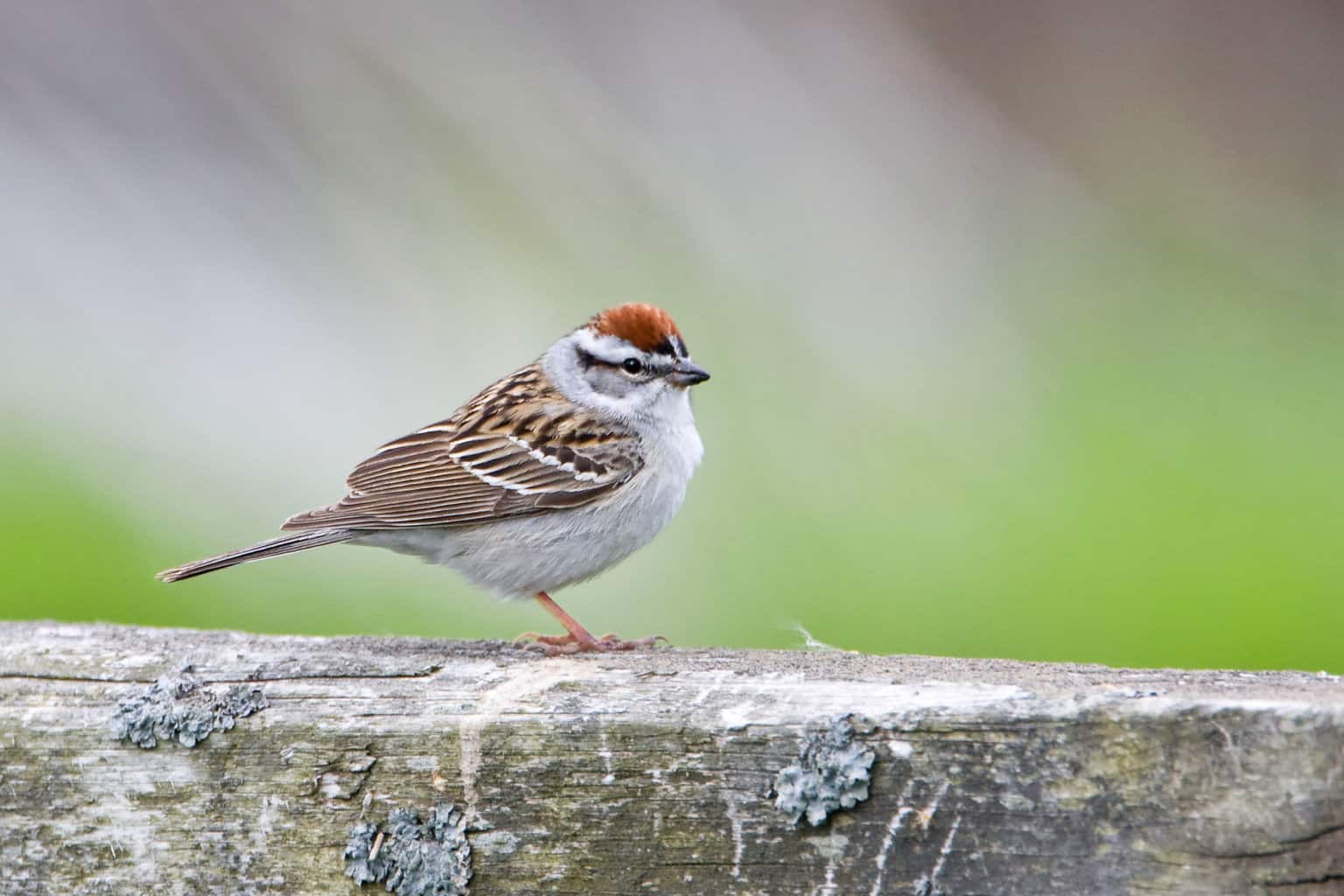
- Spizella passerina
- Order: Passeriformes
- Family: Passerellidae
- Length: 4.7-5.9 inches (12-15 cm)
- Weight: 0.4-0.6 oz (11-18 g)
- Wingspan: 7.5-9.1 inches (19-23 cm)
The Chipping Sparrow is a small songbird known for its distinctive appearance, which makes it easier to differentiate from other sparrows you may see in Louisiana. Its features include a rusty-brown cap on the head, contrasting with a gray face and a black eye-line. The back and wings are a warm brown, while the underparts are pale grayish-white.
In Louisiana, the Chipping Sparrow can be found in various habitats throughout the year. During the breeding season, it favors open woodlands, including parks, gardens, and forest edges. In winter, these sparrows may also be seen in more urban areas, such as residential neighborhoods and farmlands.
They are widespread throughout most of the US for most of the year.
Interesting facts about the Chipping Sparrow include its characteristic song, which consists of a series of dry, musical chips. They primarily feed on seeds, insects, and berries. This sparrow species is known to breed in loose colonies, where individuals defend small territories.
Lark Sparrow
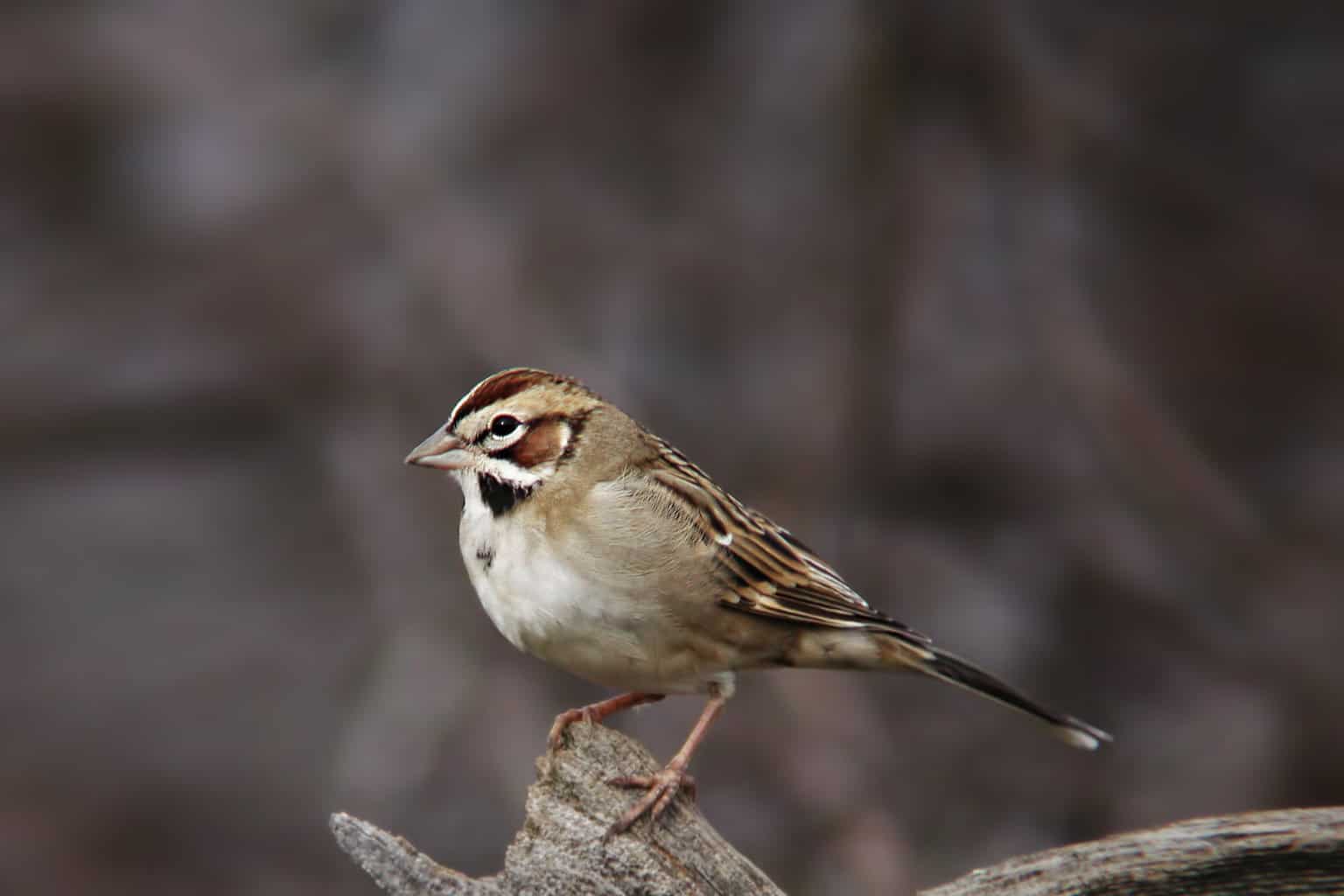
- Chondestes grammacus
- Order: Passeriformes
- Family: Passerellidae
- Length: 5.9-6.7 inches (15-17 cm)
- Weight: 0.9-1.2 oz (25-34 g)
- Wingspan: 9.4-11.0 inches (24-28 cm)
The Lark Sparrow is a medium-sized sparrow with a striking facial pattern. It has a buffy-white chest with a black spot on its breast, and the head features a bold black-and-white striped crown and a white eyebrow stripe. The back is brown with white streaks, and the wings display rufous and white patches.
In Louisiana, Lark Sparrows inhabit grasslands, open fields, and prairies with scattered shrubs. They are often found perched on fence wires or tall grass, where they sing their melodious song. These sparrows have a distinctive flight display, featuring a fluttering ascent followed by a slow, parachuting descent.
Lark Sparrows primarily feed on seeds, insects, and small fruits. They forage on the ground or low vegetation, scratching and hopping to uncover their prey. Their diet varies seasonally, with a greater emphasis on seeds during the winter months.
Lark Sparrows are summer-only residents of Louisiana who move into Mexico for the winter. There are year-round populations nearby, in Texas.
Sparrows in Louisiana in the Winter
There are more sparrows in Louisiana in the winter than at any other time of year. Many varieties travel here for the winter, after breeding somewhere further north. The winter-only sparrows in Louisiana are the Dark-Eyed Junco, the Field Sparrow, the Fox Sparrow, Harris’s Sparrow, Henslow’s Sparrow, LeConte’s Sparrow, Lincoln’s Sparrow, Nelson’s Sparrow, the Savannah Sparrow, the Song Sparrow, the Swamp Sparrow, the Vesper Sparrow, the White-Crowned Sparrow, and the White-Throated Sparrow. That’s 14 different sparrow varieties!
Dark-eyed Junco
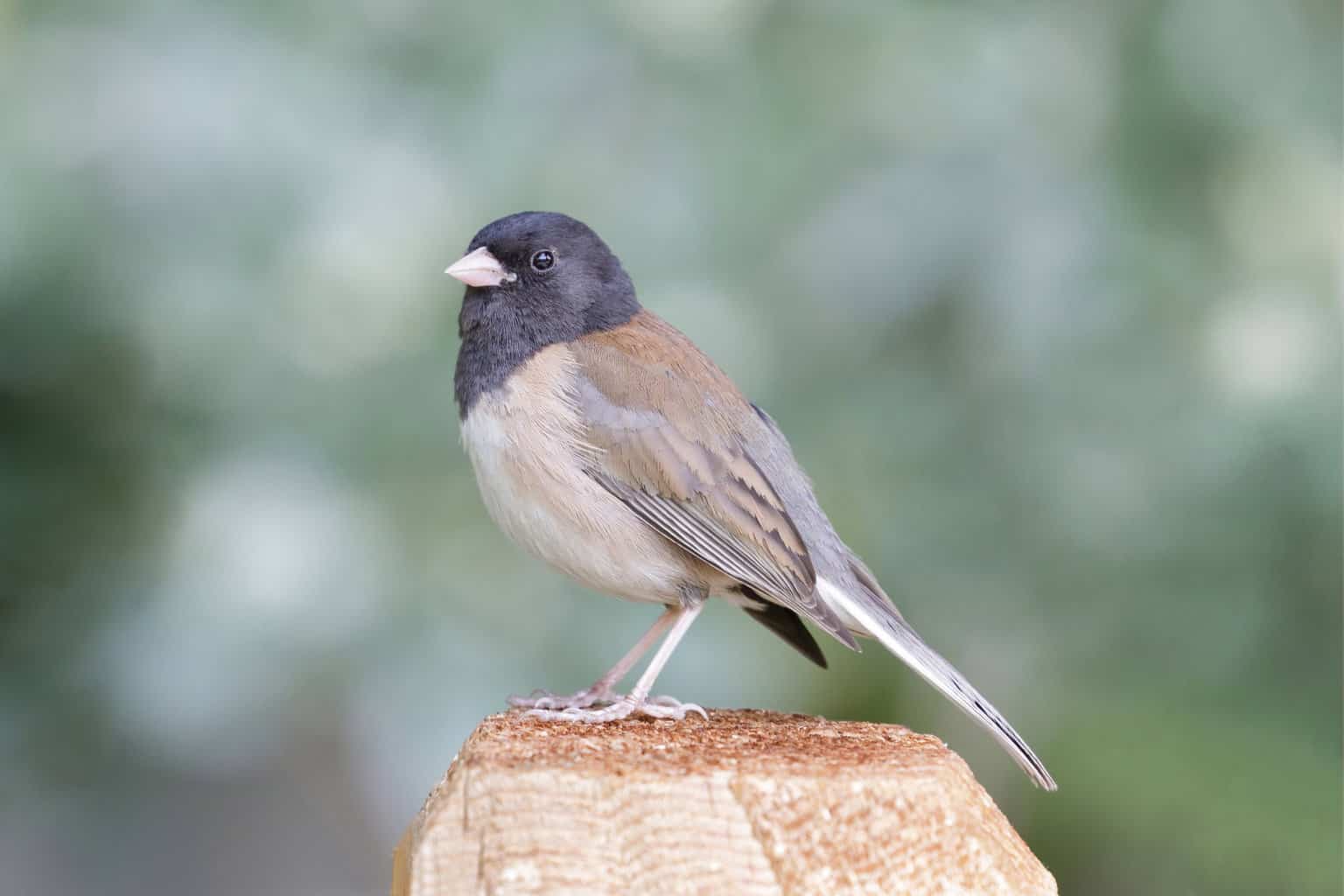
- Junco hyemalis
- Order: Passeriformes
- Family: Passerellidae
- Length: 5.1-6.3 inches (13-16 cm)
- Weight: 0.6-1.1 oz (18-31 g)
- Wingspan: 7.9-9.8 inches (20-25 cm)
The Dark-eyed Junco, which is associated with winter in most of the US, is a small sparrow known for its diverse plumage variations across different regions. Its most common form, the “slate-colored” junco, has a grayish body with a white belly and pinkish bill. Other forms exhibit variations of brown, gray, or even reddish-brown plumage.
In Louisiana, Dark-eyed Juncos are primarily found during the winter months. They inhabit various habitats, including forests, woodlands, and brushy areas. These sparrows often forage on the ground, scratching through leaf litter in search of seeds and insects.
They avoid the coastal areas and are found throughout inland Louisiana.
Field Sparrow
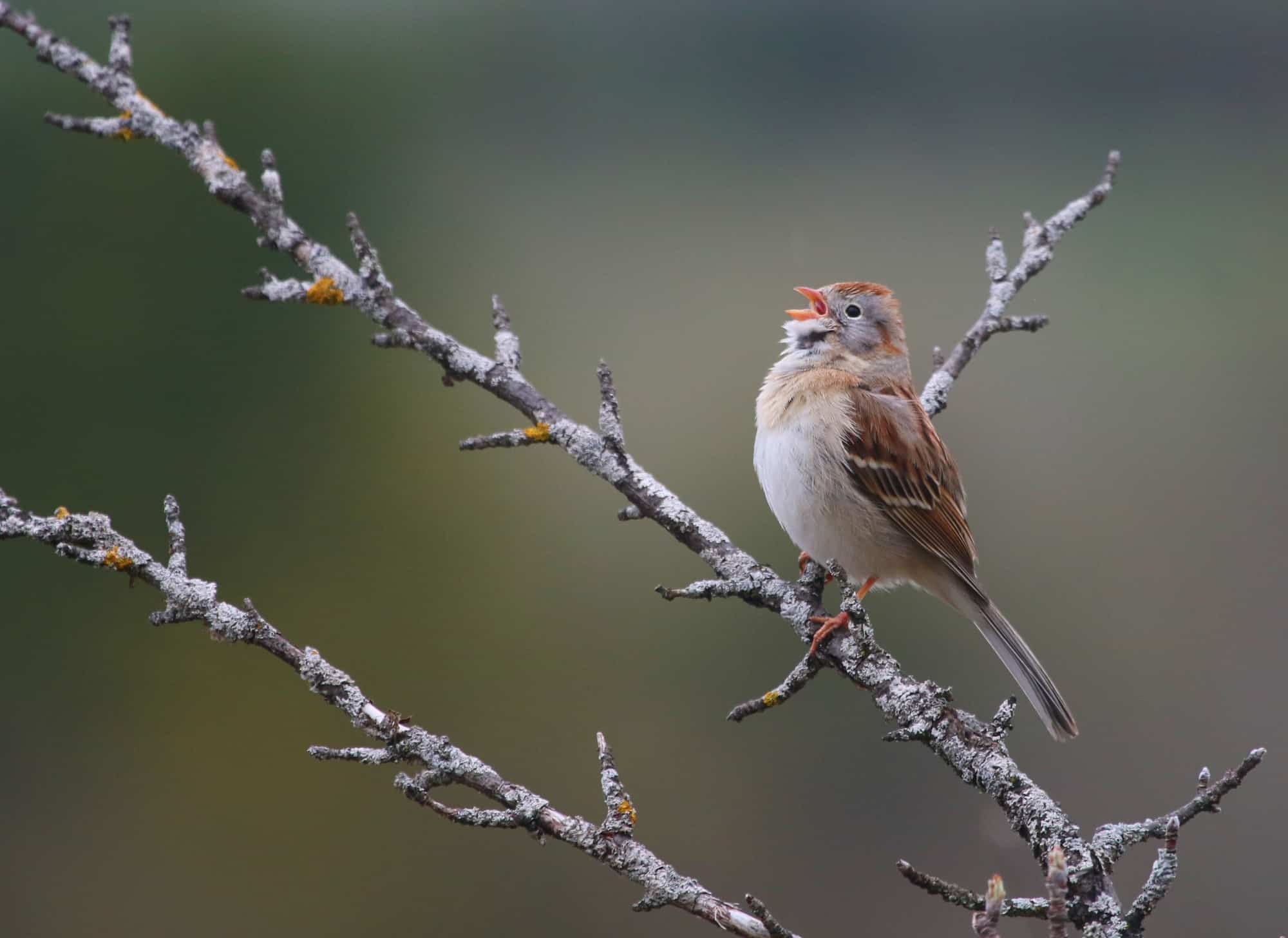
- Spizella pusilla
- Order: Passeriformes
- Family: Passerellidae
- Length: 4.7-5.9 inches (12-15 cm)
- Weight: 0.4-0.7 oz (12-20 g)
- Wingspan: 7.5-9.4 inches (19-24 cm)
The Field Sparrow is a small, charming sparrow with a subtle yet attractive appearance. It has a rusty crown, a gray face with a white eyering, and a streaked brown back. The underparts are pale grayish-brown, and the bill is pinkish.
In Louisiana, Field Sparrows can be found in a variety of open habitats, including fields, meadows, and grassy areas. They are often seen perched on shrubs or fences, singing their sweet, melodic song. These sparrows primarily feed on seeds, especially grass and weed seeds, supplemented with insects during the breeding season.
They are year-round residents of the northern half of Louisiana, and winter-only residents of the southern half.
They sing a song that is described as a bouncing ball – a trill that starts out slower and then gets faster, like a bouncing ball coming to a stop.
Fox Sparrow

- Passerella iliaca
- Order: Passeriformes
- Family: Passerellidae
- Length: 6.7-7.9 inches (17-20 cm)
- Weight: 1.1-1.8 oz (31-51 g)
- Wingspan: 10.6-11.8 inches (27-30 cm)
The Fox Sparrow is a medium-sized sparrow known for its rich, reddish-brown plumage. It has a heavily streaked chest, a white belly, and a rusty tail. The head often appears rounded, with a grayish face and a prominent eye-ring.
There is a lot of variation in the appearance of Fox Sparrows, from one area of the country to the next. Some Fox Sparrows are almost entirely red, whereas others are mostly gray with reddish-brown streaks.
During migration, Fox Sparrows can be found in Louisiana, particularly in brushy and wooded areas. They prefer habitats with dense understory vegetation, such as shrublands and forest edges. These sparrows are known for their clear, melodious songs that can be heard during the breeding season.
Fox Sparrows are winter residents of most of Louisiana, but they are usually not found around New Orleans.
Fox Sparrows primarily feed on the ground, scratching and digging through leaf litter to uncover insects, seeds, and berries. They are known for their distinctive “double-scratch” feeding behavior, where they rapidly alternate both feet to reveal hidden prey.
Harris’s Sparrow
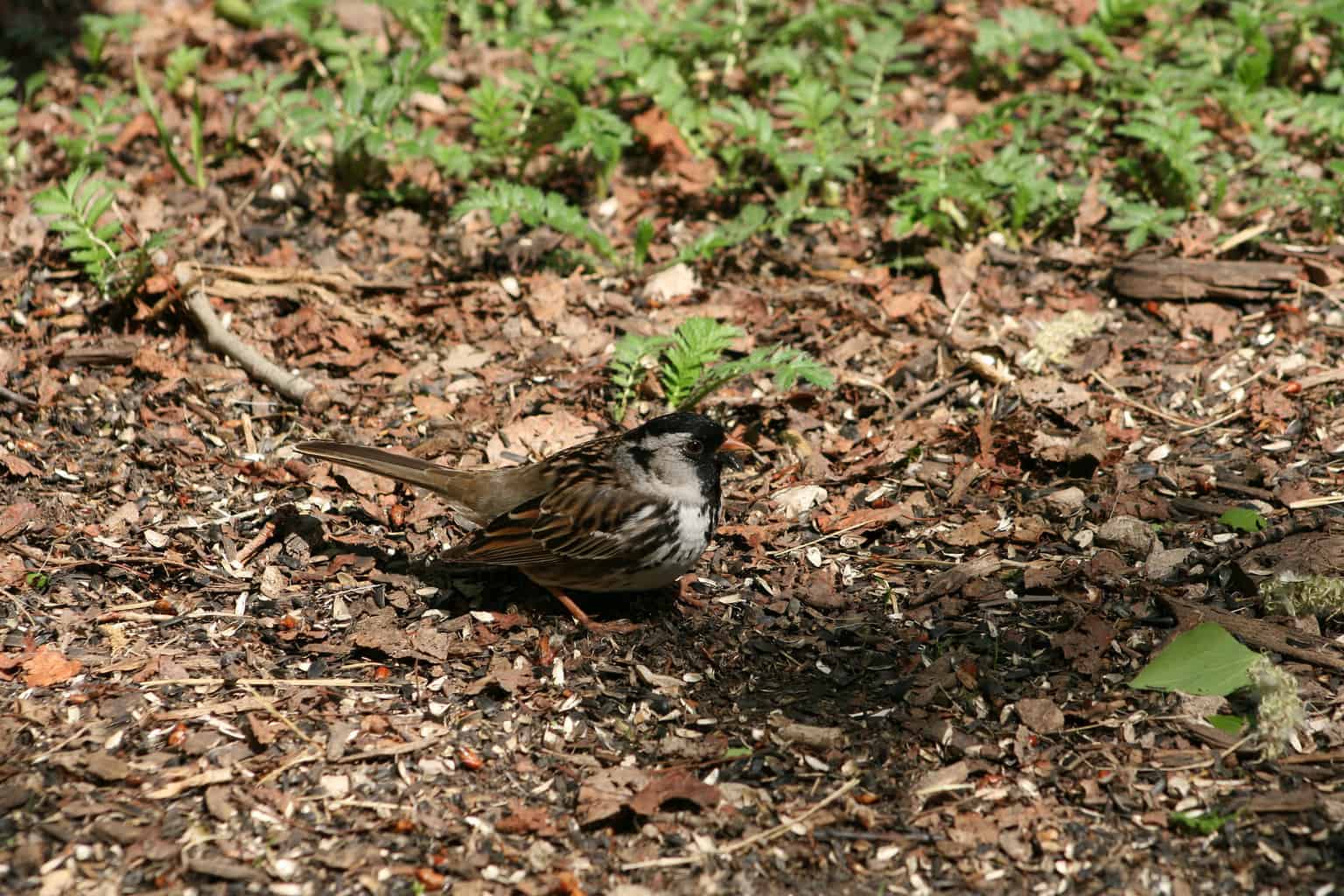
- Zonotrichia querula
- Order: Passeriformes
- Family: Passerellidae
- Length: 6.7-7.5 inches (17-19 cm)
- Weight: 1.3-1.8 oz (37-51 g)
- Wingspan: 10.6-11.8 inches (27-30 cm)
Harris’s Sparrow is a medium-sized sparrow with a striking, more noticeable appearance. It has a black crown, face, and bib, creating a sharp contrast with its white belly and grayish underparts. The wings are dark brown, and the bill is pinkish in color. This unique combination of colors makes Harris’s Sparrow stand out among other sparrows.
These sparrows can be found in various habitats, mostly in the winter. They are not an extremely common bird here, but some individuals and small groups end up here instead of in their more typical range in the Central Plains of the US.
During the winter, they migrate southward and can be spotted in Louisiana’s shrubby areas, woodland edges, and hedgerows. They tend to prefer areas with thick undergrowth and lots of vegetation where they can forage for seeds, berries, and a variety of insects.
One interesting fact about Harris’s Sparrow is that it has the most restricted breeding range of any North American passerine. They nest exclusively in the central and western parts of the Canadian Arctic. Despite their limited breeding range, they embark on an impressive long-distance migration, traveling thousands of miles to their wintering grounds in the southern United States. The Harris’s Sparrow is also known for its distinct song, a series of clear whistles that can be heard during the breeding season.
Henslow’s Sparrow
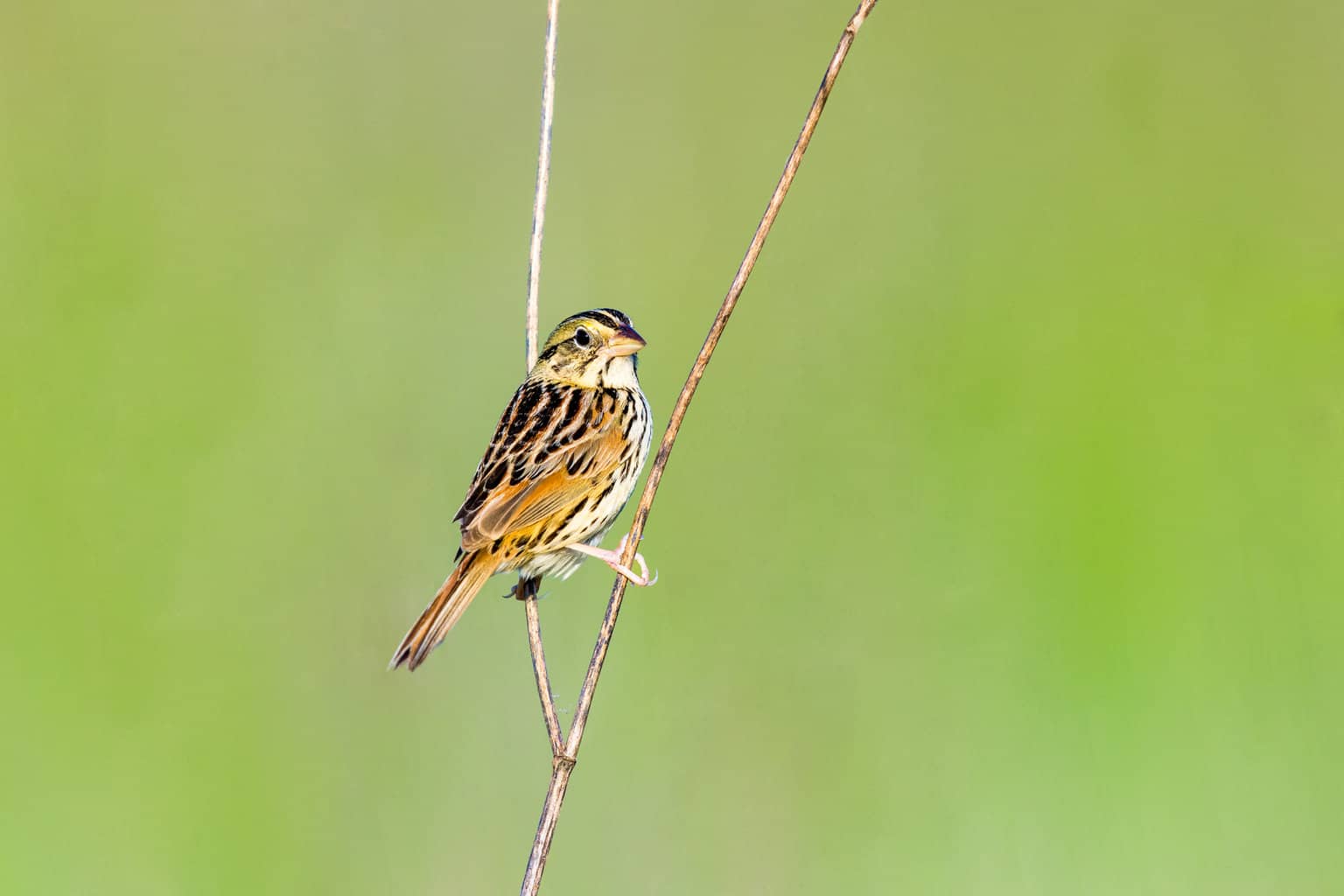
- Centronyx henslowii
- Order: Passeriformes
- Family: Passerellidae
- Length: 4.7-5.1 inches (12-13 cm)
- Weight: 0.4-0.5 oz (11-15 g)
- Wingspan: 7.9-8.3 inches (20-21 cm)
The Henslow’s Sparrow is a small and secretive sparrow with a unique appearance. It has a streaked brown back and wings, a buffy face with a thin eye-ring, and a pale belly. Males and females have similar plumage, making it challenging to differentiate between the sexes. However, the yellow wash to their feathers makes them easy to distinguish from other sparrows.
In Louisiana, Henslow’s Sparrows can be found during their breeding season in the tallgrass prairies and grassy meadows. They prefer habitats with dense grasses and forbs, where they build their nests on the ground, concealed among the vegetation.
They are found throughout the state during the winter.
These sparrows are known for their distinctive “insect-like” song, which consists of a series of high-pitched notes followed by a trill. They are more often heard than seen due to their secretive nature. They are excellent at camouflage and at hiding!
LeConte’s Sparrow
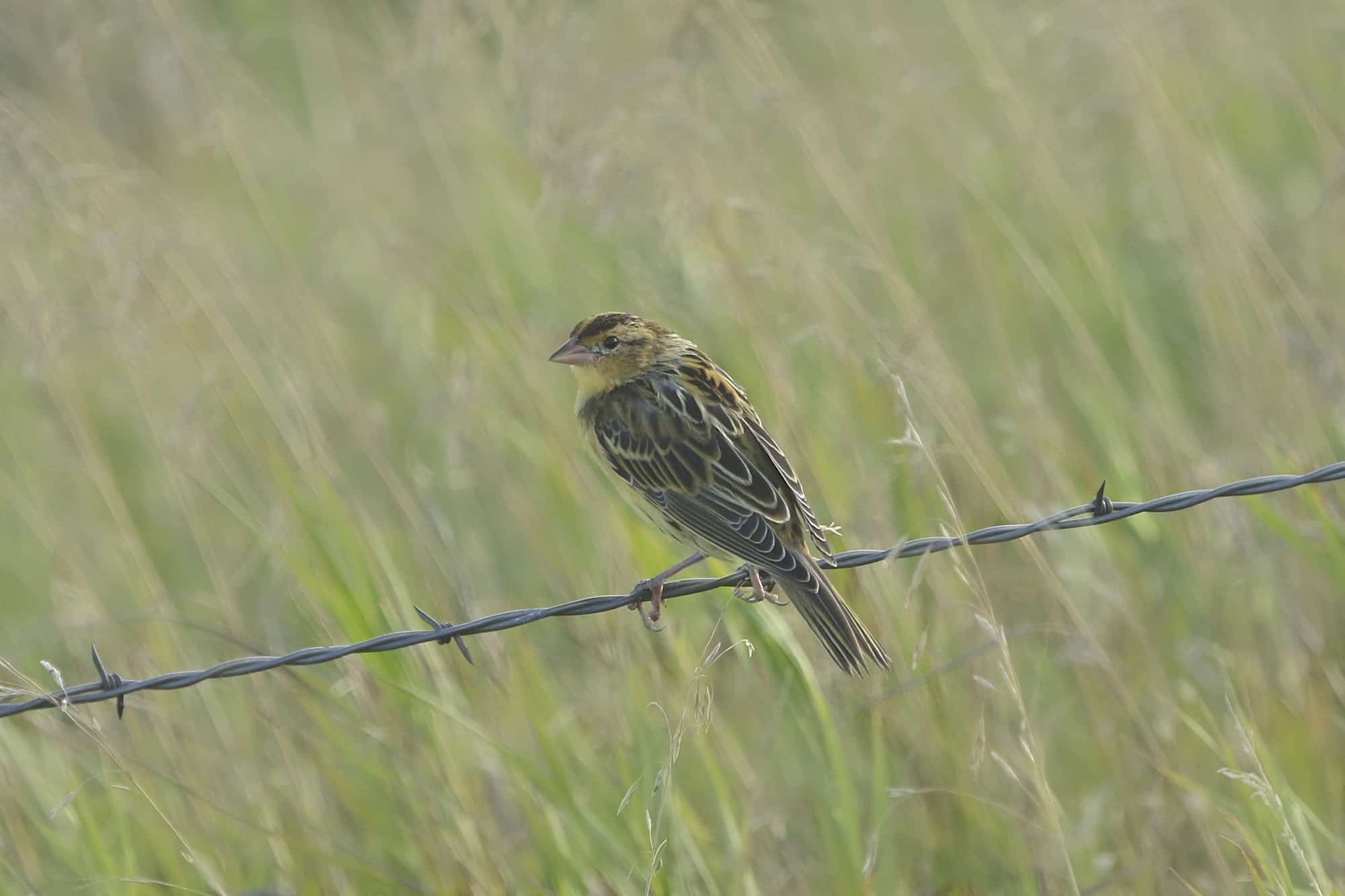
- Ammospiza leconteii
- Order: Passeriformes
- Family: Passerellidae
- Length: 4.7-5.1 inches (12-13 cm)
- Weight: 0.3-0.5 oz (8-14 g)
- Wingspan: 6.7-7.5 inches (17-19 cm)
LeConte’s Sparrow is a small sparrow known for subtle but attractive plumage. It has a streaked back with reddish-brown and black markings, a buffy face with a pale eye-ring, and a white belly. These sparrows have relatively long tails and slim bills.
During the winter months, LeConte’s Sparrows can be found in Louisiana’s marshes, wet meadows, and grassy areas. They prefer habitats with tall grasses and sedges, where they forage for seeds and insects. Their secretive nature and preference for dense vegetation make them challenging to observe.
However, their soft, musical song can be heard during the breeding season, consisting of a series of trills and whistles.
They are found throughout Louisiana in the winter months. During their breeding season, they will travel almost directly north to Canada, where they will then spread westward.
Lincoln’s Sparrow

- Melospiza lincolnii
- Order: Passeriformes
- Family: Passerellidae
- Length: 5.5-5.9 inches (14-15 cm)
- Weight: 0.5-0.7 oz (14-19 g)
- Wingspan: 7.5-8.7 inches (19-22 cm)
The Lincoln’s Sparrow is a small sparrow with intricate coloring. It has a reddish-brown back with fine black streaks, a grayish face with a distinctive buffy eye-ring, and a pale belly with streaking on the sides. These sparrows have short tails and round bodies.
During their migration, Lincoln’s Sparrows can be found in Louisiana’s woodlands, thickets, and brushy areas. They prefer habitats with dense undergrowth, where they forage on the ground for seeds and insects. Despite their subtle appearance, their song is quite melodious and complex, consisting of a series of musical notes and trills.
They stick around for the winter, throughout the entire state.
Nelson’s Sparrow
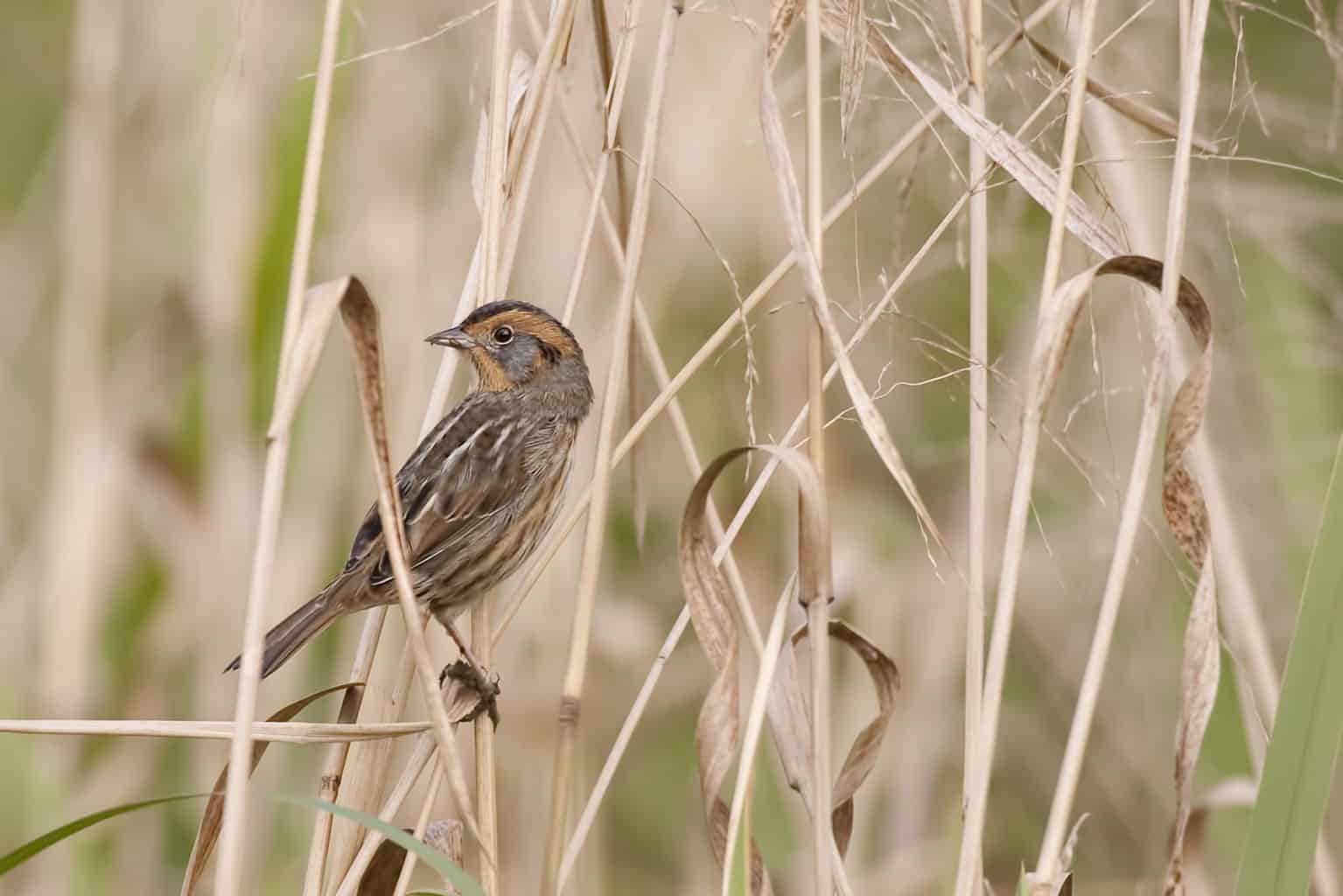
- Ammospiza nelsoni
- Order: Passeriformes
- Family: Passerellidae
- Length: 4.7-5.1 inches (12-13 cm)
- Weight: 0.4-0.5 oz (11-15 g)
- Wingspan: 6.7-7.1 inches (17-18 cm)
The Nelson’s Sparrow is a small sparrow with a distinct appearance that includes a streaked brown back and wings, a gray face with a bold central crown stripe, and a pale belly with streaking on the sides. The throat and breast are often buffy or pale gray. They have short tails and relatively round bodies.
In Louisiana, Nelson’s Sparrows can be found in wetland habitats, such as salt marshes, marshes, and coastal grasslands. They prefer areas with dense vegetation, especially cordgrass and sedges. These sparrows are known for their unique song, a series of low, insect-like buzzes and trills that carry across the marshes during the breeding season.
Despite their preference for coastal habitats, they can also be found in freshwater marshes during migration.
Savannah Sparrow

- Passerculus sandwichensis
- Order: Passeriformes
- Family: Passerellidae
- Length: 4.7-6.3 inches (12-16 cm)
- Weight: 0.4-0.7 oz (11-20 g)
- Wingspan: 7.9-10.6 inches (20-27 cm)
The charming Savannah Sparrow has some subtle yellow coloring on its belly and face. It has a streaked brown back and wings, a pale face with a central crown stripe and yellow eyebrow, and a pale yellowish belly with thin streaking. These sparrows have small bills and short tails.
In Louisiana, Savannah Sparrows can be found in a variety of habitats, including grasslands, fields, marshes, and coastal dunes. They are adaptable and can thrive in both dry and wet environments. These sparrows are known for their sweet and melodic song, consisting of a series of clear whistles and trills.
Savannah Sparrows are typically limited to Louisiana during the winter, but some live year-round in the waterways surrounding New Orleans.
Song Sparrow

- Melospiza melodia
- Order: Passeriformes
- Family: Passerellidae
- Length: 5.5-7.1 inches (14-18 cm)
- Weight: 0.8-1.1 oz (22-31 g)
- Wingspan: 7.9-9.8 inches (20-25 cm)
The delightful Song Sparrow is medium-sized with a streaked brown back and wings, a grayish face with a distinctive dark central crown stripe, and a buffy belly with heavy streaking. These sparrows have round bodies, short tails, and conical bills.
In Louisiana, Song Sparrows can be found in a variety of habitats, including woodlands, brushy areas, marshes, and suburban gardens. They are versatile and adapt well to both wet and dry environments.
These sparrows are known for their rich and melodious song, which varies among individuals and regions. Each male Song Sparrow has a unique song that they use to establish their territory and attract mates.
Swamp Sparrow

- Melospiza georgiana
- Order: Passeriformes
- Family: Passerellidae
- Length: 4.7-5.9 inches (12-15 cm)
- Weight: 0.6-0.8 oz (17-22 g)
- Wingspan: 7.9-9.1 inches (20-23 cm)
Swamp Sparrows are well-adapted to marshy habitats that are plentiful in Louisiana. They have streaked brown backs and wings, a gray face with a rusty crown, and a white belly with dark streaking. Their bodies are round and they have short tails and sturdy bills.
Louisiana’s Swamp Sparrows can be found in wetland habitats, such as marshes, swamps, and wet meadows. They are found throughout the state in the winter.
They are particularly associated with areas of dense vegetation and cattails. These sparrows are known for their unique song, which has been described as a musical trill followed by a series of buzzes. Their song can often be heard emanating from the dense vegetation during the breeding season.
Vesper Sparrow
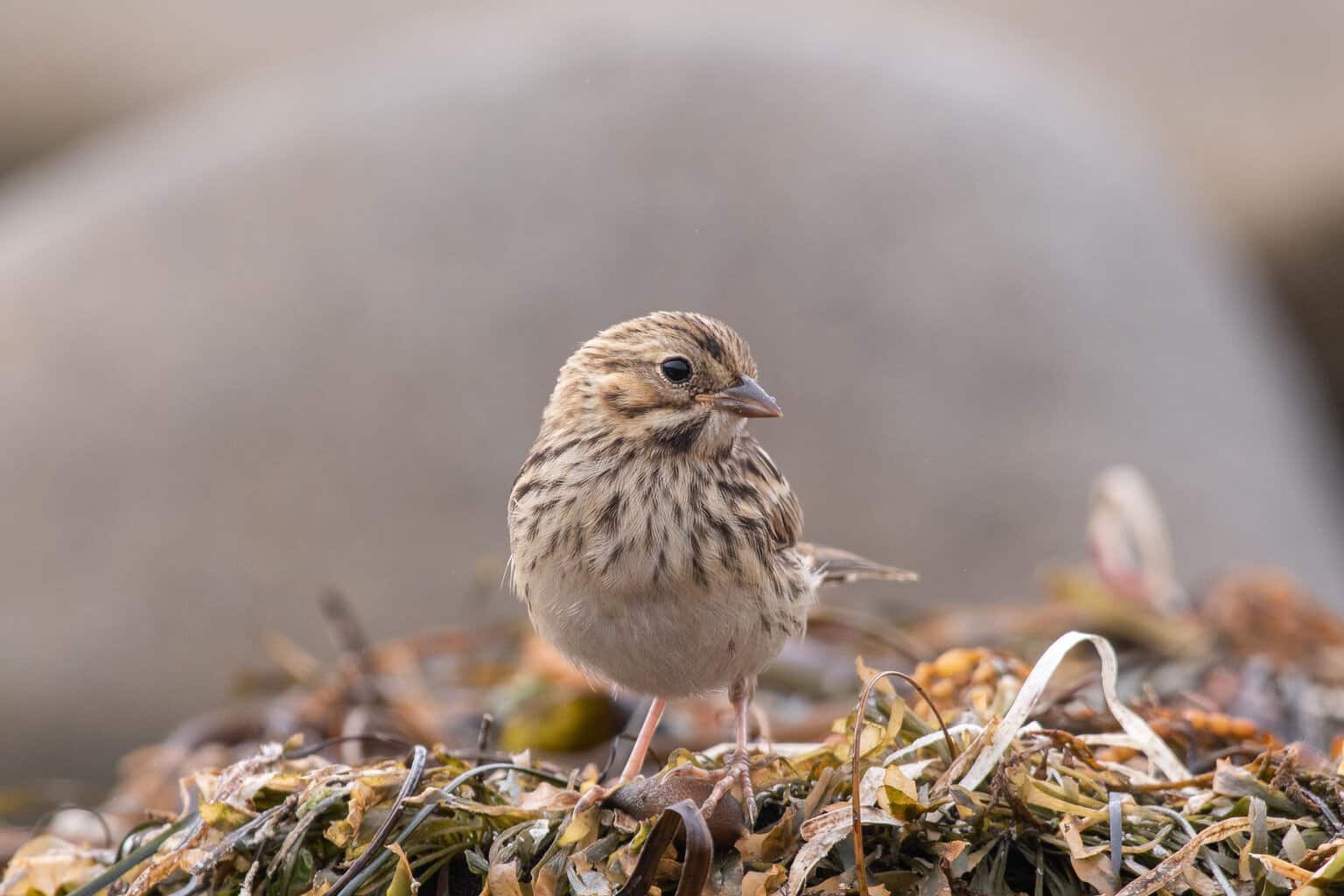
- Pooecetes gramineus
- Order: Passeriformes
- Family: Passerellidae
- Length: 5.9-6.7 inches (15-17 cm)
- Weight: 0.9-1.1 oz (25-31 g)
- Wingspan: 9.1-10.2 inches (23-26 cm)
The Vesper Sparrow is a medium-sized sparrow with subdued plumage. It has a streaked brown back and wings, a pale face with white eyerings, and a white belly with thin streaking. They have slender bodies, long tails, and pointed bills.
During the winter, Vesper Sparrows can be found in a variety of habitats, including grasslands, open fields, and agricultural areas. They are often found in areas of sparse vegetation and bare ground. These sparrows are named after their habit of singing their plaintive song during the evening hours, hence the name “vesper.” (vesper services are when some Christian traditions have a prayer service at dusk).
Their pretty song consists of a series of clear and repetitive notes.
White-Crowned Sparrow
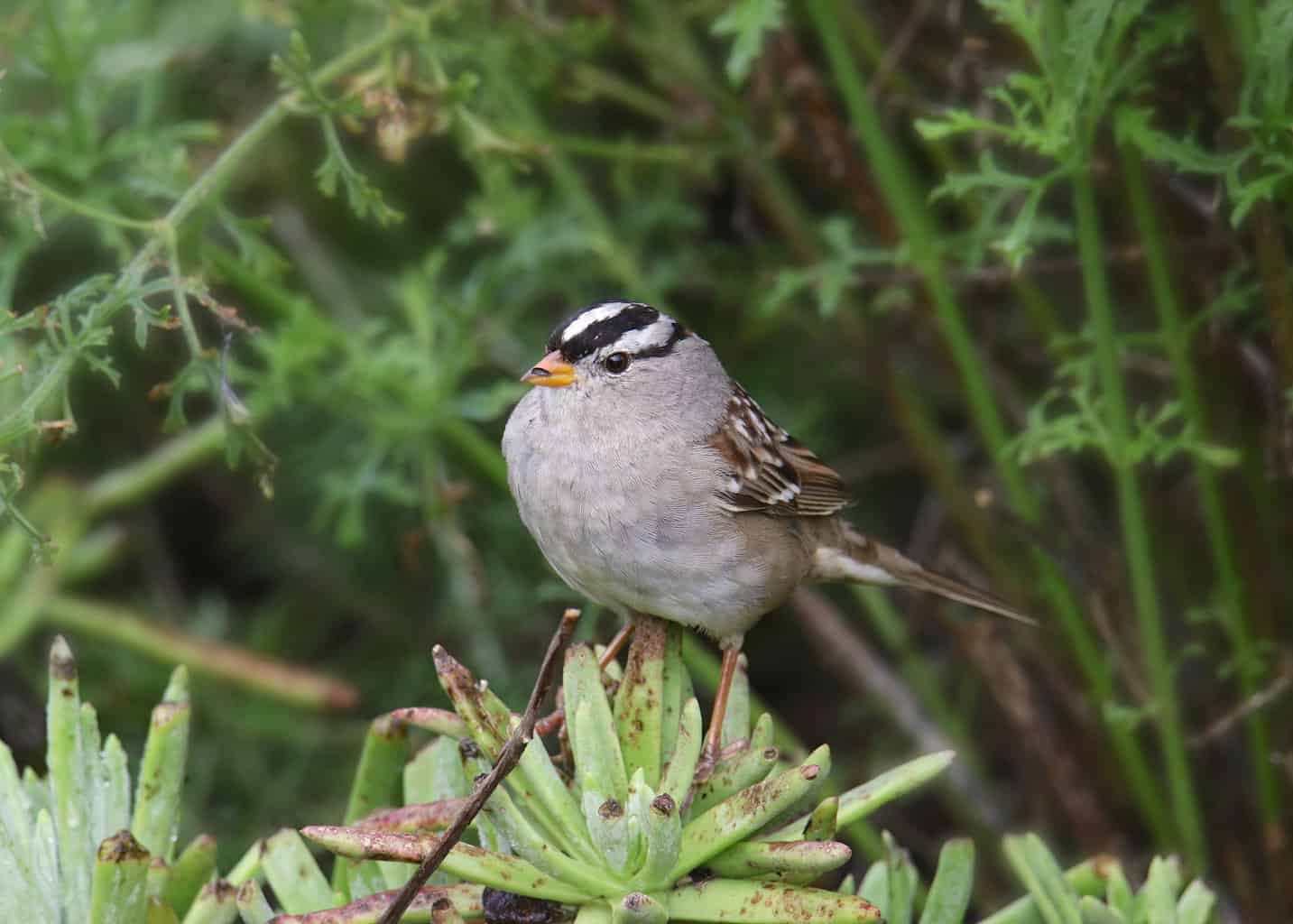
- Zonotrichia leucophrys
- Order: Passeriformes
- Family: Passerellidae
- Length: 6.3-7.5 inches (16-19 cm)
- Weight: 1.0-1.4 oz (28-40 g)
- Wingspan: 9.8-11.4 inches (25-29 cm)
White-Crowned Sparrows are medium-sized with grayish-brown backs, gray faces with bold black-and-white striped crowns and white bellies. Their bodies are sturdy, and their tail is medium-length. Like other sparrows, they have a sharp, conical bill. These sparrows have sturdy bodies, medium-length tails, and conical bills.
During migration, White-Crowned Sparrows can be found in a variety of habitats in Louisiana, including woodlands, shrubby areas, and suburban gardens. They are adaptable and can be seen in both open and more vegetated habitats. These sparrows are known for their beautiful and melodious song, which varies among individuals and populations. They are capable of producing a series of clear whistles and trills.
They are winter residents of Louisiana and can be spotted throughout the state.
White-Throated Sparrow
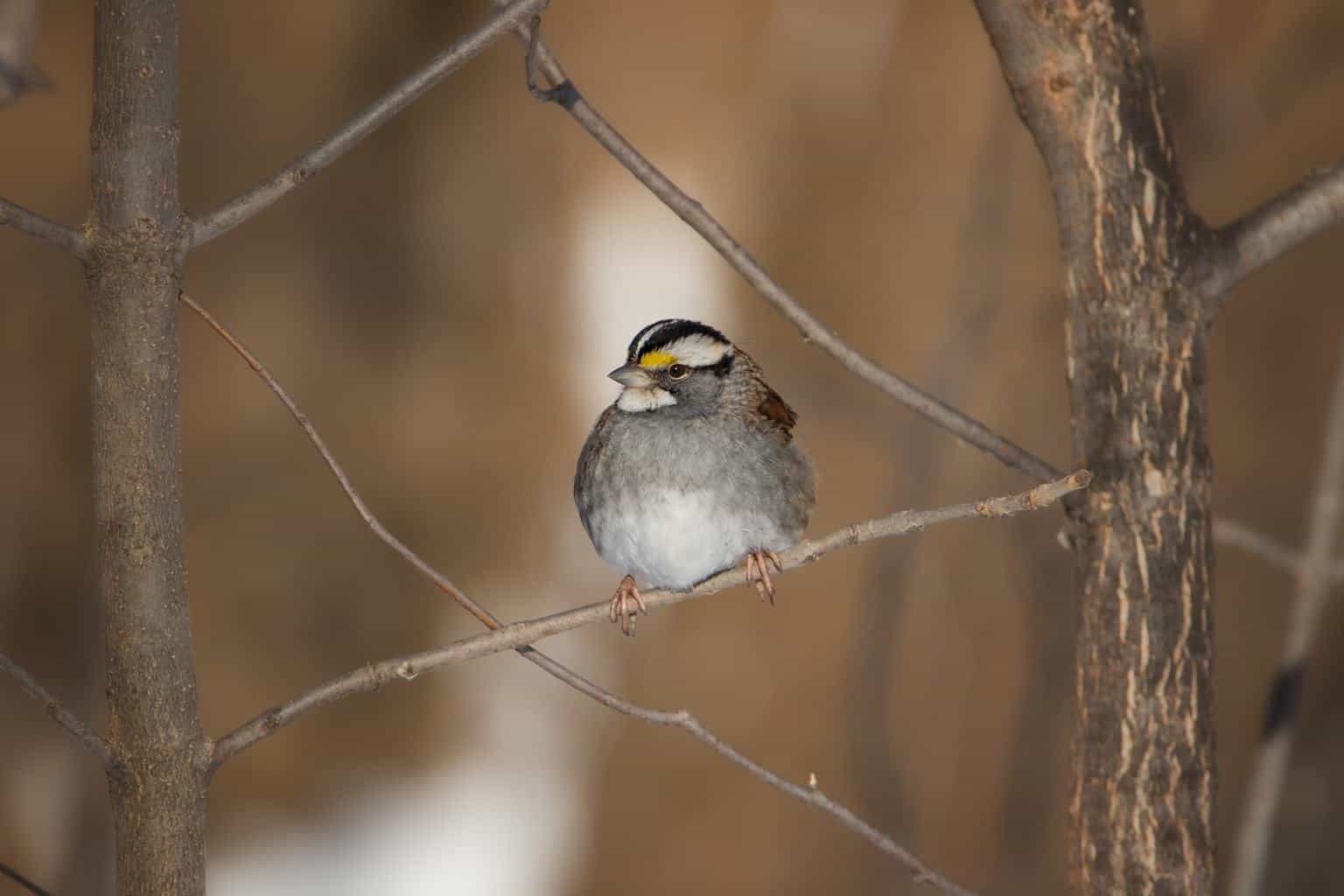
- Zonotrichia albicollis
- Order: Passeriformes
- Family: Passerellidae
- Length: 6.3-7.5 inches (16-19 cm)
- Weight: 0.9-1.1 oz (26-32 g)
- Wingspan: 9.1-11.0 inches (23-28 cm)
The White-Throated Sparrow has striking colors and a lovely song. It has a grayish-brown back, a gray face with a distinctive black-and-white striped crown, and a white throat and belly. These beautiful sparrows have sturdy bodies, medium-length tails, and conical bills.
The male’s bright yellow eyebrow helps him stand out from many other sparrows in the state.
During the winter months, White-Throated Sparrows can be found in a variety of habitats in Louisiana, including woodlands, thickets, and suburban areas. They often forage on the ground, scratching and hopping to uncover seeds and insects.
These sparrows are known for their clear and whistled song, which consists of a series of musical notes and phrases. The song is often described as “Oh sweet Canada, Canada, Canada.”
Sparrows in Louisiana During Migration
Although you will see many of the above sparrows in the spring or fall because they are long-term residents of the state, there is only one kind of sparrow that migrates through Louisiana without staying: the Clay-Colored Sparrow.
Clay-Colored Sparrow
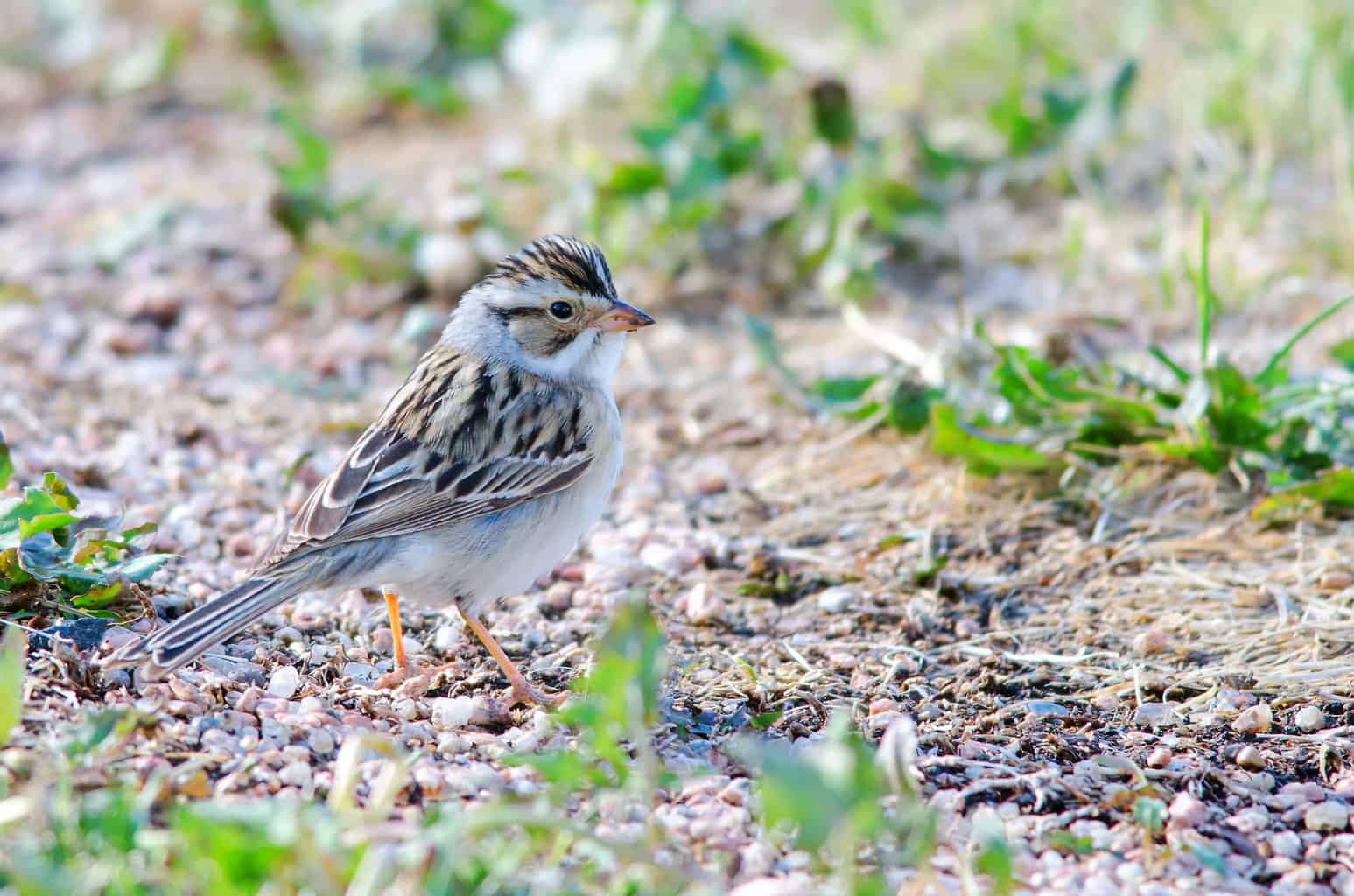
- Spizella pallida
- Order: Passeriformes
- Family: Passerellidae
- Length: 4.7-5.9 inches (12-15 cm)
- Weight: 0.4-0.6 oz (12-17 g)
- Wingspan: 7.9-9.1 inches (20-23 cm)
The Clay-Colored Sparrow is a small sparrow with subtle coloring. It has a pale grayish-brown back, a gray face with a distinct clay-colored crown, and a white belly. The Clay-Colored Sparrow has a short tail, round body, and slender bill.
During migration, which is the only time they are found in Louisiana, Clay-Colored Sparrows can be spotted in a wide variety of habitats, including grasslands, open fields, and shrubby areas. They forage on the ground for food and their diet includes a variety of seeds and small insects.
Their simple song is more distinctive than their appearance, but unfortunately, they don’t sing much during migration. Their melodic song of clear, musical notes is saved for the breeding season.
Clay-Colored Sparrows are found in the northwest corner of Louisiana as they migrate between their winter territory in Mexico and their breeding grounds in the northern US and southern Canada.
How to Spot Sparrows in Louisiana
I hope this list shows just how many fascinating sparrows can be spotted by bird watchers in Louisiana!
Although there are more sparrows here in the winter than at any other time of year, you should be able to see and identify sparrows all year long.
Once you learn to identify some of the commonly found sparrows in Louisiana, you can go from there! You are most likely going to see House Sparrows in Louisiana’s cities, White-throated Sparrows at backyard feeders, and Song Sparrows throughout the entire state.
Don’t forget to check out our guide to other interesting birds in Louisiana, including tanagers, hummingbirds, woodpeckers, blue buntings, anhingas, warblers, and even roadrunners. Enjoy your birdwatching and birding in Louisiana, and good luck learning to distinguish these many different sparrows from one another!

